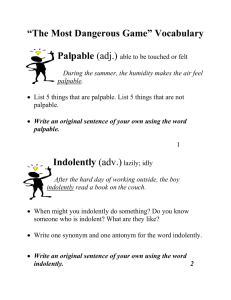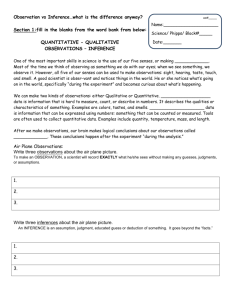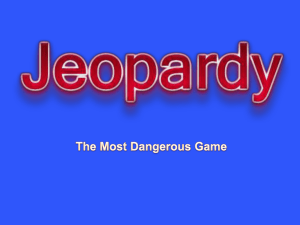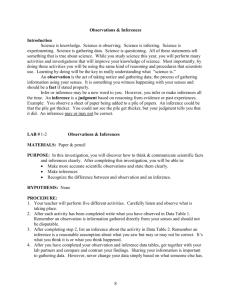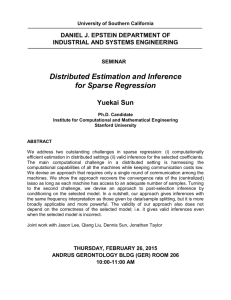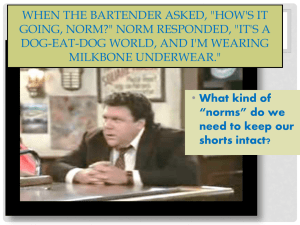background to MDG, assessments
advertisement
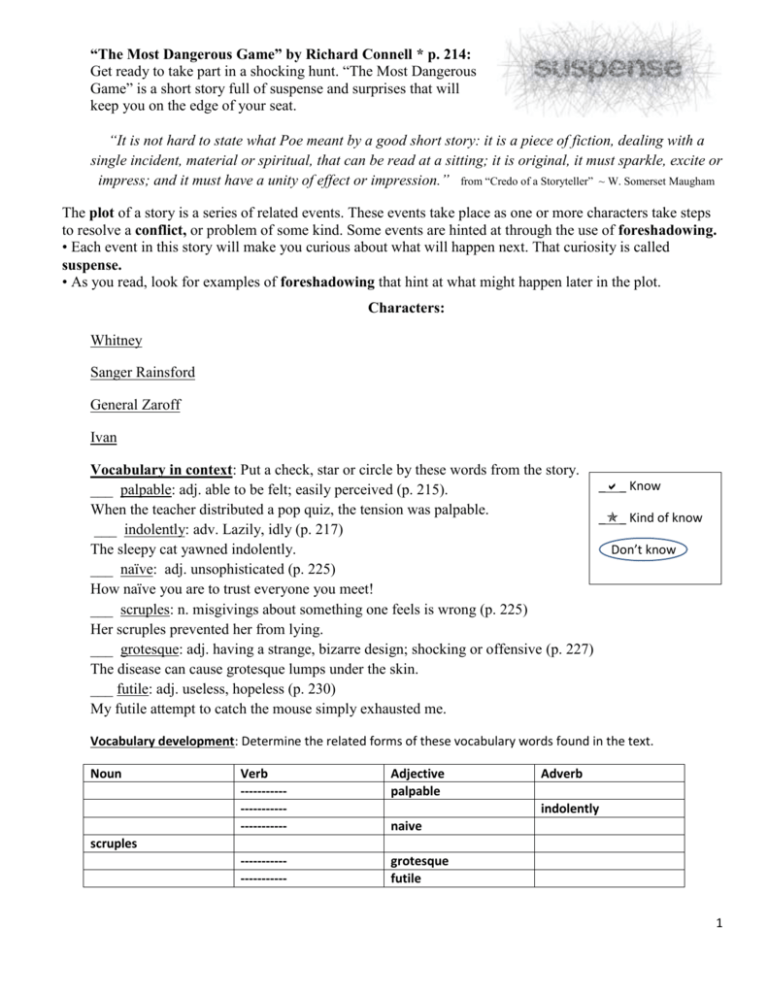
“The Most Dangerous Game” by Richard Connell * p. 214: Get ready to take part in a shocking hunt. “The Most Dangerous Game” is a short story full of suspense and surprises that will keep you on the edge of your seat. “It is not hard to state what Poe meant by a good short story: it is a piece of fiction, dealing with a single incident, material or spiritual, that can be read at a sitting; it is original, it must sparkle, excite or impress; and it must have a unity of effect or impression.” from “Credo of a Storyteller” ~ W. Somerset Maugham The plot of a story is a series of related events. These events take place as one or more characters take steps to resolve a conflict, or problem of some kind. Some events are hinted at through the use of foreshadowing. • Each event in this story will make you curious about what will happen next. That curiosity is called suspense. • As you read, look for examples of foreshadowing that hint at what might happen later in the plot. Characters: Whitney Sanger Rainsford General Zaroff Ivan Vocabulary in context: Put a check, star or circle by these words from the story. __ Know ___ palpable: adj. able to be felt; easily perceived (p. 215). When the teacher distributed a pop quiz, the tension was palpable. __ Kind of know ___ indolently: adv. Lazily, idly (p. 217) Don’t know The sleepy cat yawned indolently. ___ naïve: adj. unsophisticated (p. 225) How naïve you are to trust everyone you meet! ___ scruples: n. misgivings about something one feels is wrong (p. 225) Her scruples prevented her from lying. ___ grotesque: adj. having a strange, bizarre design; shocking or offensive (p. 227) The disease can cause grotesque lumps under the skin. ___ futile: adj. useless, hopeless (p. 230) My futile attempt to catch the mouse simply exhausted me. Vocabulary development: Determine the related forms of these vocabulary words found in the text. Noun Verb ------------------------------- Adjective palpable --------------------- grotesque futile Adverb indolently naive scruples 1 Literary terms and examples Foreshadowing: use of clues to suggest events that have yet to occur Example: Indirect characterization: author provides clues about character by what he says/does, or by what others say about him Example: Inference: an idea or conclusion that is drawn from evidence and reasoning. When you make an inference, you are reading between the lines, or just looking carefully at the facts and coming to conclusions. We make inferences all of the time! When the sky is full of gray clouds, we infer that it’s going to rain. Some inferences are poorly supported by available evidence, like when someone spends $100 on the lottery because she feels really lucky and infers that she is going to win. Example: What inferences could you make about Whitney (p. 215-216)? Conflict: (man vs. self, man vs. man, man vs. nature, man vs. society) Example: Imagery: use of words or phrases that appeal to the senses (sight, hearing, touch, taste or smell) Example: How do you know the writer meant this? Authors don’t expect readers to create inferences out of nothing. Authors provide information (external text); readers use that information in a variety of ways to create their internal text. When authors are not providing literal information, then they are implying something. Authors imply; therefore, readers have to infer. To help make inferences: 1. Look for pronouns and figure out how to connect them. 2. Determine explanations for events. 3. Think about the setting, and see what details you can add. 4. Think about something that you know about the topic and see how that fits with what’s in the text. 5. After you read this section, see if you can explain why the character acts this way. 6. Look at how the character said (insert a specific quote). How would you have interpreted what that character said if he had said (change how it was said or stress different words)? 7. Look for words that you don’t know, and see if any of the other words in the sentence or surrounding sentences can give you an idea for what those unknown words mean. 8. As you read this section, look for clues that would tell you how the author might feel about (insert a topic or character’s name). 2 Conflict: Example: Irony: Difference between what is, and what’s expected Example: Inference, p. 219 Example: History connection, p. 221: Ivan and Zaroff are Cossacks, members of a people from southern Russia who also made up a special Russian military unit. As a group, Cossacks were famous for their fierceness, and the soldiers enjoyed a privileged status. Because of their elite positions, these soldiers were also fiercely independent. When the czar, the ruler of Russia, was overthrown in the Russian Revolution of 1917, Cossacks like Zaroff were executed or forced into exile. As a Cossack, Zaroff is unwilling to acknowledge that the rules of ordinary people apply to him. Irony Example: Direct characterization: character directly described by the author, the narrator or by other characters Example: Foreshadowing Example: Internal conflict Example: Inference, p. 226 Example: 3 Inference, p. 227 Example: Imagery Example: External conflict Example: Inference, p. 228: Example: Metaphor: Direct comparison, not using like or as: p. 229 (“My love is a red, red rose,”) Example: Indirect characterization Example: Words that build conflict, p. 230-231: The author uses words to enhance the conflict and convey tension. What words on these pages indicate a struggle, a physical or mental strain, fear, doubt or danger? List three: Inference, p. 231 Example: Metaphor Example Personification: A figure of speech where animals, ideas or inorganic objects are given human characteristics Example: Conflict Example Metaphor Example 4
